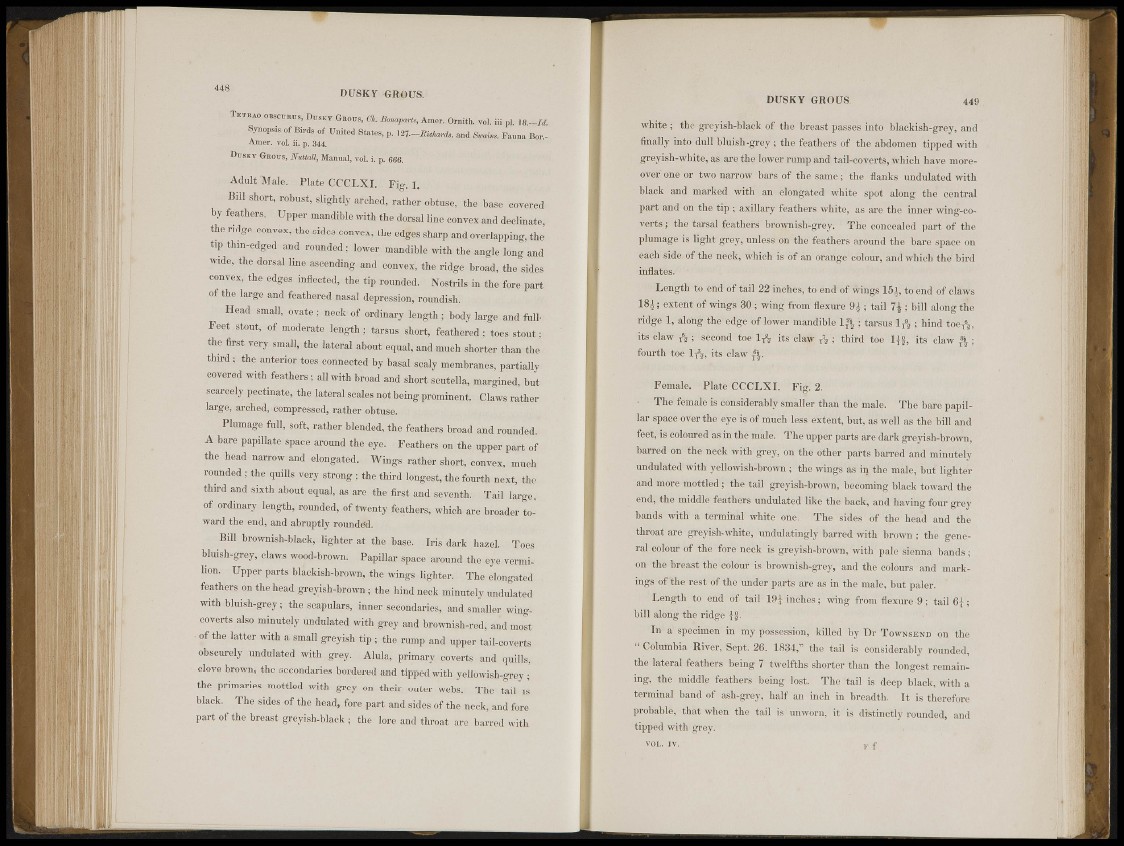
DUSKY GROUS.
TKTRAO OKSCI.'RX'S. DCSKV .G»„,:s, a . A«,*«,, Amur. Ornith. V„H ¡¡! pj. ,«. J,I.
^ S B f j o f Birds of United States, p. 1 2 7 - i ? « . and Smim. tanna Jior-
Amer. vol. ii. p. 344.
DNSJJY OBOUS. XMUXU. Manual, IOL i. p. 666.
Adult 'MjiIc. l'iato CCCI.XI. Fig. 1.
. Bill short, K>W, sligrtly arched, rather obtSfte, the base covered
by feathers».?. Upper man,m,lo with the dorsal lip® c „moH, » l declinate
the ridge convex, t h e « * » convex, the ed£es sharp and overlapping, the
tip thin-edged and rounded," lower mandible with the angle-Iong and
« d e , the dorsal line aisoeffdHguand convex, the ridge broad, the sides
'"""f i X ' tip rounded. Nostrils in the fore-part
of the large and feathered nasal depression, roundish.
Head small, ovate^neok of ordinary length, body large and ftdh.
E e | stent, of-moderate length; tarsus short, featured; toeji stent;
the first very small, the lateral about equals and much shorter than the
third ; the anterior toes connected by basal scaly membranes, partially
covered with feathers -, all with broad and short-sctella, margined, but
scarcely pectinate, the lateral scalegaot,being prominent. Claws rather
large, .arched, compressed, rather obtuse. ,
Plumage full, soft, rather blended, thefoathers broad and rounded.
A bare papillate-spape around the eye. ..Feathers^n the upper part of
the head narrow and elongate^, - Wings rather short, convex, much
rounded v thè (¡«ills very strong : the third lougest, the fourth next. the.
third and sixth about equal, as are the first aftdkseventh Tail large,
of or,Unary length, rounded,.of twenty feathers,- which are broader toward
thtsoud, and abruptly roundffi.
.Bill brownish-black, lighter at the base. Iris dark hazel. 18»
blui.sli-o-ro.j-, daws wood-brown. Papilla* space around the ove vermilem
- Upper-parts bÙckish-brown, the wings lighter. The elongated
feather* on the head, greyish-brown jul,«; hind neck minutely undulated
with bluish-grey; the scapulars, inner secondaries, and .smaller wing,
coverts a ^ i minutely andulated with grey and brownish-red, fed most
of the latter with a small greyish tip ; the rump and upper tail-coverts '
obscurely undulated with gr.ey. Alula, primary Aver t s and quill,*.:
dove.brown, the secondaries bordered and tipped with yellowish-grey •
the primaries mottled with grey on their outer webs. The tail is '
black. The sides, of the hoad, fore part and sides of the nock, and fore
part of the breast greyish-black ; the,; lore ani throat aro barred with
DUSKY GROÜS. 449
white ; the greyish-black of the breast passes -into blackish-grey, and
finally into dpi bluish-grey ; the feathers of the abdomen tipped with
greyish-white, as are the lower rump and tail-coverts, which have moreover
one or two narrow bars of the samo ; the Hanks undulated with
black and marked with an elongated white spot along thè central
part and on the tip ; axillary feithcrs white, as are the inner wing-coverts
; the tarsal feathers brownish-grey. The; concealed part of the
plumage is light grey, unless on the feathers around the bare space on
each side, of the neck, which is of an orange colour, and which the bird
inflates.-'• *
Length to end of tail 22 ¡riches.-'tñ ,-rol of wings 15.;, to end of claws
18j ; extent of wings 30 ; wing from flexure 9j ' M l 7j ; bill along the
ridge 1, along the edge of lower mandible 1||, ; tarsus l rV; hind tóéTV
its claw & ; second toe lT
a, its daw A ; third foe its claw fy ;
fourth toé ÍÁ, its claw ft,.
Femalci1'' Plate (JKCLXI. Fig: 2.
The feinale is considerably smaller than the male. Thè bare papillar
space over the eye is of much less extent, but, as well as the bill and
feet, is coloured as in the male.''' The upper parts are dark greyish-brown,
barred on' the neck with grey, on tlio other parts barred and minutely
undulated with yellowish-brown ; the wings as in thè male, but lighter
and more mottled'-; the tail greyish-brown, b e coming black toward thè
i f i l the middle feathers undulated like the back, and having four grey
bands with a terminal white one. The sides of the head and the
throat, are grevisb-white, undulatingly barred with brown ; the general
colour of the fore neck is greyish-brown, with pale sienna bands ;
on the breast the colour is brownish-grey, and thC'Silours and markings
of the rest of the under parts are as in the male, but paler. '
Length to end uf tail 19J inches; wing from flexüfé9; tail 6^;
bill along the ridge
Mn a specimen in my possession, killed by Dr TOWNSEND on the
" Columbia River, Sept. 26. 1834," the tail is considerably rounded,
the lateral; feathers being 7 twelfths shorter than the longest remaining,
the middle feathers being lost. The tail is deep black, with a
terminal band of ash-grey, half an inch in breadth. It is therefore
probable, that when the-tail is unworn, it is; distinctly rounded, and
tipped with grey.
VoTS TV. * K fg